电子科技大学:《语言学通论 General Linguistics》课程教学资源(课件讲稿)语义学——Semantics(Sense Relations)

General Linguistics Semantics:Sense Relations 楚军 外国语学院
Semantics: Sense Relations 楚军 外国语学院 General Linguistics
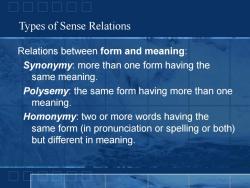
Types of Sense Relations Relations between form and meaning: Synonymy:more than one form having the same meaning. Polysemy:the same form having more than one meaning. Homonymy:two or more words having the same form (in pronunciation or spelling or both) but different in meaning
Types of Sense Relations Relations between form and meaning: Synonymy: more than one form having the same meaning. Polysemy: the same form having more than one meaning. Homonymy: two or more words having the same form (in pronunciation or spelling or both) but different in meaning
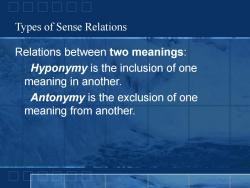
Types of Sense Relations Relations between two meanings: Hyponymy is the inclusion of one meaning in another. Antonymy is the exclusion of one meaning from another
Types of Sense Relations Relations between two meanings: Hyponymy is the inclusion of one meaning in another. Antonymy is the exclusion of one meaning from another
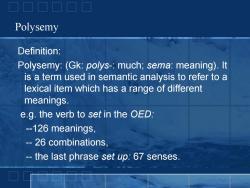
Polysemy Definition: Polysemy:(Gk:polys-:much;sema:meaning).It is a term used in semantic analysis to refer to a lexical item which has a range of different meanings. e.g.the verb to set in the OED. --126 meanings, --26 combinations, -the last phrase set up:67 senses
Definition: Polysemy: (Gk: polys-: much; sema: meaning). It is a term used in semantic analysis to refer to a lexical item which has a range of different meanings. e.g. the verb to set in the OED: --126 meanings, -- 26 combinations, -- the last phrase set up: 67 senses. Polysemy
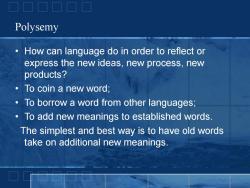
Polysemy How can language do in order to reflect or express the new ideas,new process,new products? To coin a new word; To borrow a word from other languages; To add new meanings to established words. The simplest and best way is to have old words take on additional new meanings
• How can language do in order to reflect or express the new ideas, new process, new products? • To coin a new word; • To borrow a word from other languages; • To add new meanings to established words. The simplest and best way is to have old words take on additional new meanings. Polysemy
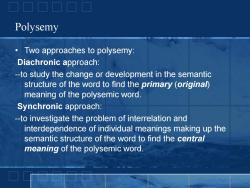
Polysemy Two approaches to polysemy: Diachronic approach: --to study the change or development in the semantic structure of the word to find the primary (original) meaning of the polysemic word. Synchronic approach: --to investigate the problem of interrelation and interdependence of individual meanings making up the semantic structure of the word to find the central meaning of the polysemic word
• Two approaches to polysemy: Diachronic approach: --to study the change or development in the semantic structure of the word to find the primary (original) meaning of the polysemic word. Synchronic approach: --to investigate the problem of interrelation and interdependence of individual meanings making up the semantic structure of the word to find the central meaning of the polysemic word. Polysemy
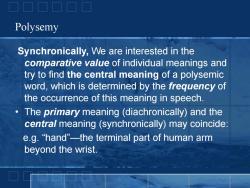
Polysemy Synchronically,We are interested in the comparative value of individual meanings and try to find the central meaning of a polysemic word,which is determined by the frequency of the occurrence of this meaning in speech. The primary meaning (diachronically)and the centra/meaning (synchronically)may coincide: e.g.“hand”-the terminal part of human arm beyond the wrist
Synchronically, We are interested in the comparative value of individual meanings and try to find the central meaning of a polysemic word, which is determined by the frequency of the occurrence of this meaning in speech. • The primary meaning (diachronically) and the central meaning (synchronically) may coincide: e.g. “hand”—the terminal part of human arm beyond the wrist. Polysemy
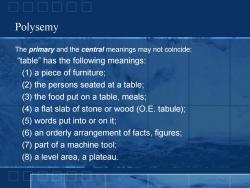
Polysemy The primary and the central meanings may not coincide: “table”has the following meanings: (1)a piece of furniture; (2)the persons seated at a table; (3)the food put on a table,meals; (4)a flat slab of stone or wood (O.E.tabule); (5)words put into or on it; (6)an orderly arrangement of facts,figures; (7)part of a machine tool; (8)a level area,a plateau
Polysemy The primary and the central meanings may not coincide: “table” has the following meanings: (1) a piece of furniture; (2) the persons seated at a table; (3) the food put on a table, meals; (4) a flat slab of stone or wood (O.E. tabule); (5) words put into or on it; (6) an orderly arrangement of facts, figures; (7) part of a machine tool; (8) a level area, a plateau
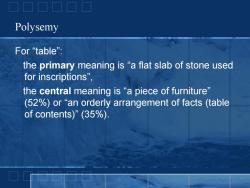
Polysemy For“table”: the primary meaning is "a flat slab of stone used for inscriptions”, the central meaning is "a piece of furniture" (52%)or "an orderly arrangement of facts (table of contents)”(35%)
For “table”: the primary meaning is “a flat slab of stone used for inscriptions” , the central meaning is “a piece of furniture” (52%) or “an orderly arrangement of facts (table of contents)” (35%). Polysemy
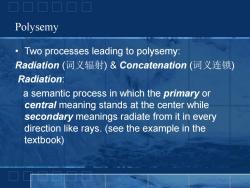
Polysemy Two processes leading to polysemy: Radiation(词义辐射)&Concatenation(词义连锁) Radiation: a semantic process in which the primary or centra/meaning stands at the center while secondary meanings radiate from it in every direction like rays.(see the example in the textbook)
Polysemy • Two processes leading to polysemy: Radiation (词义辐射) & Concatenation (词义连锁) Radiation: a semantic process in which the primary or central meaning stands at the center while secondary meanings radiate from it in every direction like rays. (see the example in the textbook)
按次数下载不扣除下载券;
注册用户24小时内重复下载只扣除一次;
顺序:VIP每日次数-->可用次数-->下载券;
- 电子科技大学:《语言学通论 General Linguistics》课程教学资源(课件讲稿)语义学——Types of word-meaning.pdf
- 电子科技大学:《语言学通论 General Linguistics》课程教学资源(课件讲稿)07 Semantics(Introduction).pdf
- 电子科技大学:《语言学通论 General Linguistics》课程教学资源(课件讲稿)06 Functional Grammar.pdf
- 电子科技大学:《语言学通论 General Linguistics》课程教学资源(课件讲稿)05 句法 Syntax.pdf
- 电子科技大学:《语言学通论 General Linguistics》课程教学资源(课件讲稿)04 Formalist Approach.pdf
- 电子科技大学:《语言学通论 General Linguistics》课程教学资源(课件讲稿)03 Formalist Approach.pdf
- 电子科技大学:《语言学通论 General Linguistics》课程教学资源(课件讲稿)02 句法 Syntax.pdf
- 电子科技大学:《语言学通论 General Linguistics》课程教学资源(课件讲稿)01 Introduction(主讲:楚军).pdf
- 山东省“成人教育特色课程”项目配套教材:《大学语文》课程教材电子版(主编:戴永新).pdf
- 聊城大学:《大学语文》课程教学资源(阅读文献)中国现当代文学经典作品选.pdf
- 聊城大学:《大学语文》课程教学资源(阅读文献)外国文学经典作品选.pdf
- 聊城大学:《大学语文》课程教学资源(阅读文献)中国古代文学经典作品选.pdf
- 聊城大学:《大学语文》课程教学资源(电子教案讲义,共十五讲).docx
- 运城学院:《文学概论 literature theory》课程教学资源(电子教案,打印版,2/2,共两编八章).pdf
- 运城学院:《文学概论 literature theory》课程教学资源(电子教案,打印版,1/2,共三篇八章).pdf
- 运城学院:《文学概论 literature theory》课程教学资源(教学大纲,打印版).pdf
- 运城学院:《秘书写作 Daily practical Writing》课程PPT教学课件(事务文书写作)15.总结述职报告.ppt
- 运城学院:《秘书写作 Daily practical Writing》课程PPT教学课件(事务文书写作)14.讣告悼词.ppt
- 运城学院:《秘书写作 Daily practical Writing》课程PPT教学课件(事务文书写作)13.欢迎欢送答谢表扬邀请信.ppt
- 运城学院:《秘书写作 Daily practical Writing》课程PPT教学课件(事务文书写作)12.聘书.ppt
- 电子科技大学:《语言学通论 General Linguistics》课程教学资源(课件讲稿)语义学——Context, changes in word meaning, figures of speech.pdf
- 电子科技大学:《语言学通论 General Linguistics》课程教学资源(课件讲稿)语义学——Componential Analysis.pdf
- 电子科技大学:《语言学通论 General Linguistics》课程教学资源(课件讲稿)语义学——Sentence meaning(Predication Analysis).pdf
- 电子科技大学:《语言学通论 General Linguistics》课程教学资源(课件讲稿)10 Langugae, culture & society.pdf
- 电子科技大学:《语言学通论 General Linguistics》课程教学资源(课件讲稿)09 Pragmatics(Utterance Meaning).pdf
- 电子科技大学:《语言学通论 General Linguistics》课程教学资源(课件讲稿)形态学 Morphology.pdf
- 电子科技大学:《语言学通论 General Linguistics》课程教学资源(课件讲稿)认知语言学中的相关话题 Cognitive Linguistics.pdf
- 弟子规(全文).pdf
- 《中国语言文化 Chinese Language and Culture》课程教学资源(书籍阅读材料)《中国古典哲学名著选读》郭齐勇.pdf
- 《中国语言文化 Chinese Language and Culture》课程教学资源(书籍阅读材料)《唐诗三百首》中英文对照(许渊冲)300 Tang Poems(Classified by Theme).pdf
- 《中国语言文化 Chinese Language and Culture》课程教学资源(书籍阅读材料)《二十四诗品校注译评》祖保泉.pdf
- 《中国语言文化 Chinese Language and Culture》课程教学资源(书籍阅读材料)《近代中国之种族观念》刘东.pdf
- 《中国语言文化 Chinese Language and Culture》课程教学资源(书籍阅读材料)《中国现代女作家与中国革命1905-1948》颜海平.pdf
- 《中国语言文化 Chinese Language and Culture》课程教学资源(书籍阅读材料)《世界秩序与文明等级》全球史研究的新路径(主编:刘禾).pdf
- 《中国语言文化 Chinese Language and Culture》课程教学资源(书籍阅读材料)《叫魂》SOULSTEALERS - The Chinese Sorcery Scare of 1768〔美〕孔飞力(1768年中国妖术大恐慌).pdf
- 电子科技大学:《中国语言文化 Chinese Language and Culture》课程教学资源(课件讲稿)导论(聂韬).pdf
- 电子科技大学:《中国语言文化 Chinese Language and Culture》课程教学资源(课件讲稿)第一讲 周易.pdf
- 电子科技大学:《中国语言文化 Chinese Language and Culture》课程教学资源(课件讲稿)第七讲 谶纬之学.pdf
- 电子科技大学:《中国语言文化 Chinese Language and Culture》课程教学资源(课件讲稿)第三讲 山海经.pdf
- 电子科技大学:《中国语言文化 Chinese Language and Culture》课程教学资源(课件讲稿)第二讲 尚书.pdf
